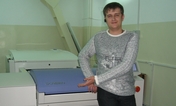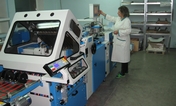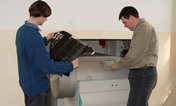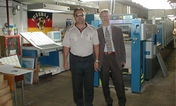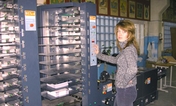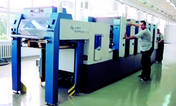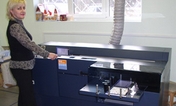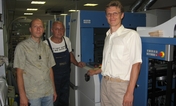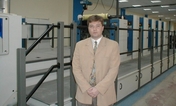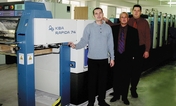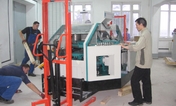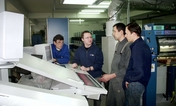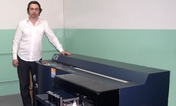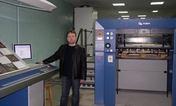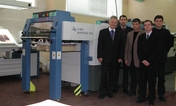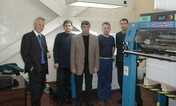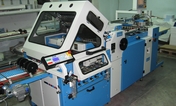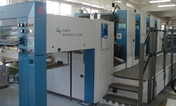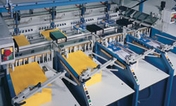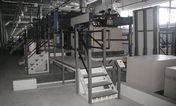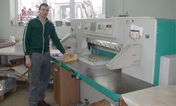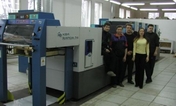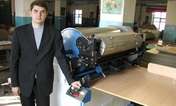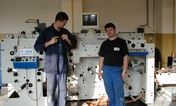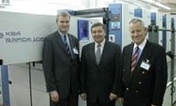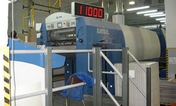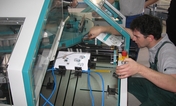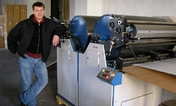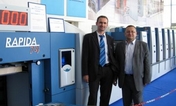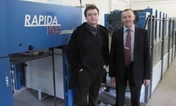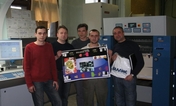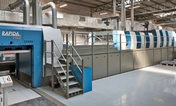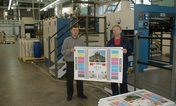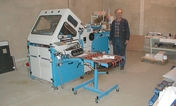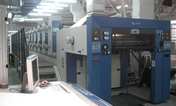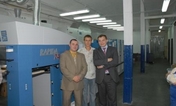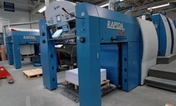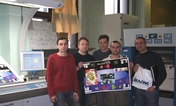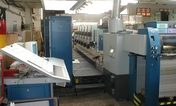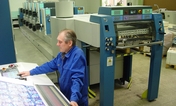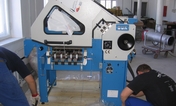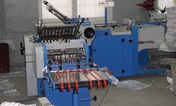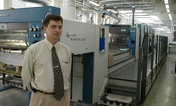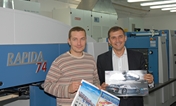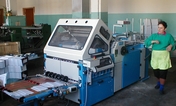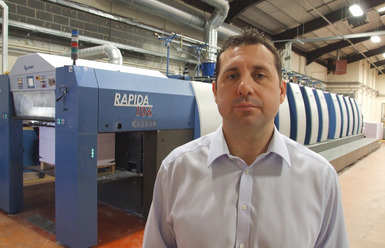By Jenny Roper, Monday 30 June 2014
Goodall: “We’re regularly making ready within eight minutes”
But few will probably be able to express this with quite the specificity of APS Group. Thanks to impressively thorough KPI tracking, the company was aware that its average makeready time was, around the beginning of last year, 25–30 minutes. It had calculated from this that 27% of shift time was spent on makereadies. And that this equated to around 13 weeks a year.
This then was the motivation for investing, in May and then September last year, in two B1 10-colour KBA Rapida 106 long perfector presses.
Not that APS Group is all about pressroom number crunching and a sole focus on print production. The print facilities at its Cheadle Heath press hall are just one aspect of the business. Since being established as Allied Publicity Services in Manchester in 1961, APS Group’s multi-discipline mix has expanded to include marketing communications, from creative services, digital publishing, data management and cross-media campaigns to logistics, fulfilment and project management.
APS did look at kit from rival manufacturers when shopping for the press. But the firm felt that becoming the first UK printer with this particular technology, rather than opting for a more proven machine, would pay off in terms of the close care and attention KBA would offer.
The first Rapida the firm installed in May of last year replaced three Manroland presses — five-and six-colour straight presses and a 10-colour perfector — and was installed alongside another existing Manroland 10-colour. APS had agreed with KBA that if the first Rapida proved to be a success it would invest in a second one within 12 months. It took just three months before APS was ready to replace its remaining Manroland with a second KBA.
The results, then, have been everything the company could have hoped for. Print capacity has been boosted by 45%–50%, reports production director Stephen Goodall.
“The machines just haven’t flinched; we’re regularly making ready within eight minutes for four-back-four and three minutes for four-colour one side,” says Goodall.
Thanks to these fast makereadies, the litho side of the business can now process shorter run lengths. “As long as there’s added value in the job, as long as it touches most components in the finishing hall, we would have no problem doing right down to 500 sheets in run length,” says Goodall.
Layout benefits
Reducing press line-up footprint by replacing four machines with two has enabled APS to boost efficiency through pressroom layout as well. The team has been able to bring its digital printing kit into this main press hall. “There’s now no wasted time in transferring jobs between machines; the time reduction getting from A to B has been significant,” he notes.
Indeed such efficiency gains wouldn’t have been possible without a complete overhaul of the pressroom, reports Goodall. He explains that APS has worked with a supplier (which it declined to name due to being the first company with a system of this kind) to produce a software package for analysing pressroom data, and that this system highlighted the need for a supporting finishing upgrade at the time of the Rapida installs.
“When we looked at all the data, we realised our bindery, our folder and stitching lines in particular, really wouldn’t have been able to deal with the quicker throughput,” reports Goodall. “So we took five MBO folders out and replaced them with four Heidelberg Stahl folders. We took two Muller Martini stitching lines out and replaced them with a Heidelberg ST 450.”
He adds: “We did invest in dehumidification kit too — that’s had a positive effect on transfer of paper through the machines and into our bindery.”
The real stars of the show have nonetheless been the KBAs. The machines have suffered no issues apart from the expected “teething problems” of any new install.
Features Goodall and his team have been particularly impressed with include the Rapida 106’s feeding and transport system, and its environmental performance. “I’ve seen a massive reduction in blanket use, and a reduction in compressed air and energy use,” he says, adding: “The feeder and delivery are sublime, the travel of paper on the perfecting unit is incredible and we’re not having issues with marking; spray is kept to a minimum.”
Particularly impressive, says Goodall, is the Rapida’s inline inspection system. “It not only keeps an eye on colour on the run and makes adjustments automatically without intervention, it also scans the imagery on the sheet and compares that to the pass sheet,” he says.
“If a deviation occurs the camera system will pick it up and highlight where that deviation is occurring, allowing the operators to pull that out. Whereas before there would be 1,000 sheets that would have passed through.”
The machines have also proved a dream to work with for APS’s operators, says Goodall. He puts this down partly to similarities between KBA and Manroland configurations. But says credit must go to his pressroom team, and to those who provided set up and training.
“I’m incredibly proud of the print professionals that have taken the machine room to what it is now and made it work so well that we decided to purchase the second machine earlier,” he says. “It’s a credit not only that the machine’s automation and sustainability technology have done everything KBA said they would, but also to the APS and KBA teams.”
With such impressive production figures under its belt, it’s little wonder APS has become one of KBA’s proudest success stories. The vendor awarded APS its 1814 Production Excellence Award last November, and regularly takes customers on tours to see the things APS is up to.
Goodall adds that having such cutting-edge technology in its pressroom means the company is even more proud than ever to show its own customers around. “It’s an extension to that impressive customer journey from client services and digital and the studio, into print services and logistics — that all has the same feel now.”
Although APS declined to comment on whether a third KBA Rapida would ever be on the cards, Goodall offered this concluding comment: “Both companies will continue working together to develop ideas.”
He adds: “The machine has just performed beyond our dreams.”
SPECIFICATIONS
Max sheet size 740x1,060mm
Min sheet size 340x480mm (straight), 400x480mm (perfecting)
Max speed straight press
Up to 9 printing units + coater or 10 printing units: 18,000sph
With high-speed package (option): 20,000sph
Max speed perfecting press
Perfector press up to 10 printing units in straight mode: 18,000sph
Prefector press up to 10 printing units in perfecting mode: 15,000sph
With high-speed package (option): 18,000sph
In the original version of this article we stated that the maximum perfecting speed was 15,000sph. However, APS opted for the high-speed package on its press, so that should have been 18,000sph. Apologies for any confusion caused.
Stock thickness 0.04–0.7mm (up to 1.2mm or 1.6mm with board/corrugated package)
Plate changing Automatic, DriveTronic Simultaneous Plate Change (SPC)
Cleaning CleanTronic Synchro — multi-purpose washing system for blanket and impression cylinders, and rollers
Inspection ErgoTronic — Integrated Camera Register (ICR)
Colour ErgoTronic ColorControl, QualiTronic PSO Match, QualiTronic Quality Pass, QualiTronic ColorView, QualiTronic DotView
Price Around GBP 3m for this specification
Contact KBA UK 01923 819922 www.kba.com/gb
Company profile
Ever since its inception as Allied Publicity Services in Manchester in 1961, APS has offered its clients media solutions of which print has been an important part, but not the whole story. Today the APS Group is a GBP 65m-turnover enterprise for which print is still an important element, but the multi-discipline mix has expanded to include marketing communications from creative services, digital publishing, data management and cross-media campaigns to logistics, fulfilment and project management. Print items range from high-security transactional print to point-of-sale and packaging, to catalogues, brochures and report & accounts.
Why it was bought…
Two KBA Rapida 106s were brought in — one in September last year, one in May this year — to replace four Manroland machines. Ever watchful of production KPIs, APS Group was keen to boost capacity and lower the footprint of its press line-up so that the pressroom could be more intelligently organised to maximise efficiency.
How it has performed…
The team at APS could not be more thrilled with the purchases. The gamble of becoming the first UK printer with a 10-colour Rapida 106 long perfector has more than paid off, reports production director Stephen Goodall. Testament to the first install’s success was the fact the second was commissioned so quickly after this. “The machine has just performed beyond our dreams,” says Goodall.
Source: PrintWeek.com

